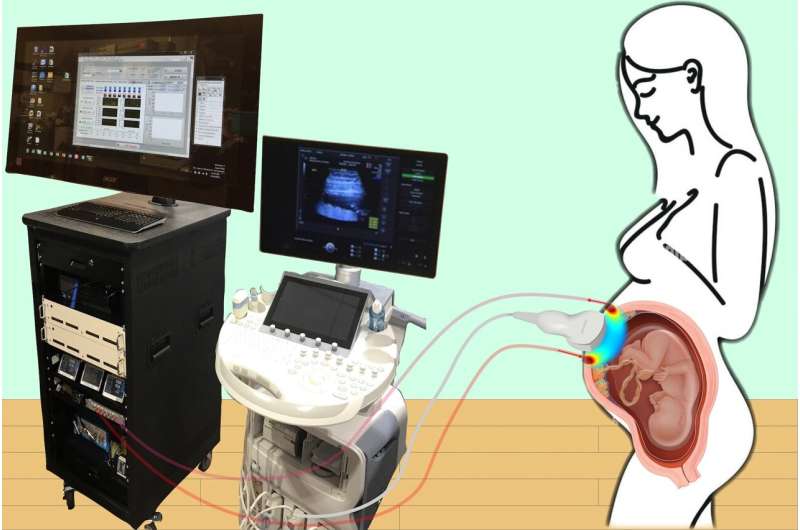
A study published in Nature Biomedical Engineering details a novel method for imaging the placenta in pregnant patients as well as the results of a pilot clinical study. By combining optical measurements with ultrasound, the findings show how oxygen levels can be monitored noninvasively and provides a new way to generate a better understanding of this complex, crucial organ. This research was the result of a collaboration of the groups of the University of Pennsylvania’s Arjun Yodh and Nadav Schwartz with colleagues from the Children’s Hospital of Philadelphia (CHOP) and was led by postdoc Lin Wang.
Schwartz describes the placenta as the “engine” of pregnancy, an organ that plays a crucial role in delivering nutrients and oxygen to the fetus. Placental dysfunction can lead to complications such as fetal growth restriction, preeclampsia, and stillbirth. To increase knowledge about this crucial organ, the National Institute of Child Health and Human Development launched the Human Placenta Project in 2014. One focus of the program is to develop tools to assess human placental structure and function in real time, including optical devices.
For three years, the researchers optimized the design of their instrument and tested it in preclinical settings. The process involved integrating optical fibers with ultrasound probes, exploring various ultrasound transducers, and improving the multimodal technology so that measurements were stable, accurate, and reproducible while collecting data at the bedside. The resulting instrumentation now enables researchers to study the anatomy of the placenta while also collecting detailed functional information about placenta blood flow and oxygenation, capabilities that existing commercially devices do not have, the researchers say.
Because the placenta is located far below the body’s surface, one of the key technical challenges addressed by Wang, a postdoc in Yodh’s lab, was reducing background noise in the opto-electronic system. Light is scattered and absorbed when it travels through thick tissues, Yodh says, and the key for success was to reduce background interference so that the small amount of light that penetrates deep into the placenta and then returns is still large enough for a high-quality measurement.
“We’re sending a light signal that goes through the same deep tissues as the ultrasound. The extremely small amount of light that returns to the surface probe is then used to accurately assess tissue properties, which is only possible with very stable lasers, optics, and detectors,” says Yodh. “Lin had to overcome many barriers to improve the signal-to-noise ratio to the point where we trusted our data.”
Notably, the paper also describes the results of a pilot study where 24 pregnant patients in their third trimester were given supplemental oxygen for a short time period, creating placental hyperoxia. Using the device, the team collected measurements of the placenta’s oxygenated and deoxygenated blood concentrations before and during hyperoxia; the results demonstrated that the device could be used to study placental function in real time. The research also provided new insights into the relationship between blood flow and maternal vascular malperfusion, which occurs when blood flow into the placenta is impeded.
“Not only do we show that oxygen levels go up when you give the mom oxygen, but when we analyze the data, both for clinical outcomes and pathology, patients with maternal vascular malperfusion did not have as much of an increase in oxygen compared to patients with normal placentas,” says Schwartz. “What was exciting is that, not only did we get an instrument to probe deeper than commercial devices, but we also obtained an early signal that hyperoxygenation experiments can differentiate a healthy placenta from a diseased placenta.”
While the device is still in development, the researchers are currently refining their instrument to make it more user-friendly and to allow it to collect data faster. The team is also currently working on larger studies, including recent data from patients during their second trimester, and they are also interested in studying different regions of the placenta. “From an instrumentation perspective, we want to make the operation more user-friendly, and then we want to carry out more clinical studies,” Wang says about the future of this work. “We have lots of interesting ideas.”
Source: Read Full Article